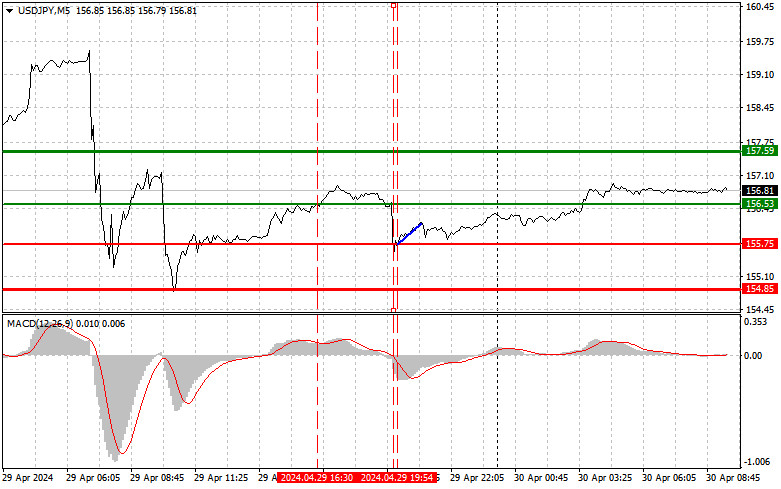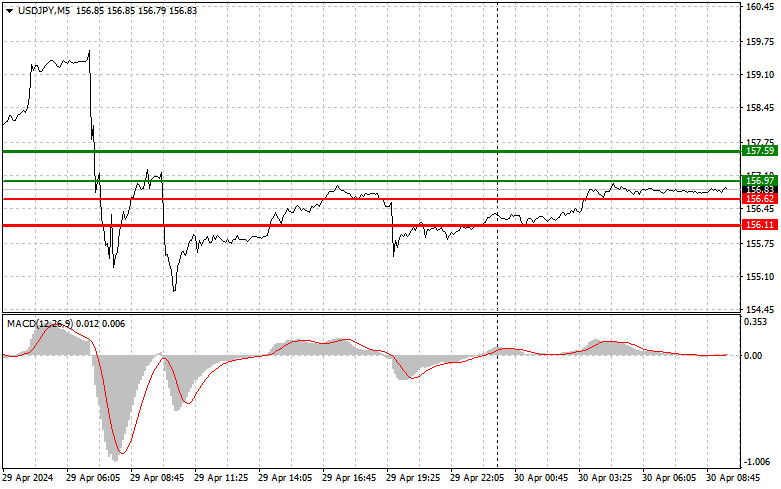
The price test of 156.53 at the beginning of the US session occurred at a time when the MACD indicator sharply rose from the zero mark, which limited the pair's upward potential. After the next Bank of Japan currency intervention, there was a price test of 155.75. But it occurred when MACD went down a lot, so I preferred to wait for one more test of the level to realize the second scenario for buying. Unfortunately, the pair only rose by 30 pips and that was the end of it, which is very little considering yesterday's volatility. Today we can see how the market is gradually going back to normal, as the BOJ no longer intervenes in the currency market. Most likely, traders will use the pair's dips to take long positions, which I also plan to take advantage of in the first half of the day as the bullish market develops. As for the intraday strategy, I will rely more on the implementation of scenarios No. 1 and No. 2.

Scenario No. 1. I plan to buy USD/JPY today when the price reaches the entry point around 156.97 plotted by the green line on the chart, aiming for growth to 157.59 plotted by the thicker green line on the chart. In the area of 156.59, I'm going to exit long positions and open short ones in the opposite direction, expecting a movement of 30-35 pips in the opposite direction from that level. You can count on USD/JPY's growth today in continuation of the upward trend - especially after traders quickly bought out all the BOJ's efforts to contain the yen's weakness. Before buying, make sure that the MACD indicator is above the zero mark and is just starting to rise from it.
Scenario No. 2. I also plan to buy USD/JPY today in case of two consecutive tests of 156.62 at the time when the MACD indicator is in the oversold area. This will limit the downward potential of the pair and lead to an upward reversal of the market. We can expect growth to the opposite levels of 156.97 and 157.59.
Sell signalsScenario No. 1. I plan to sell USD/JPY today only after testing the level of 156.62 plotted by the red line on the chart, which will lead to a rapid decline in the price. The key target for sellers will be 156.11, where I am going to exit short positions and also immediately open long ones in the opposite direction, expecting a movement of 20-25 pips in the opposite direction from that level. Pressure on USD/JPY may return in case of another central bank intervention. Before selling, make sure that the MACD indicator is below the zero mark and is just starting to decline from it.
Scenario No. 2. I also plan to sell USD/JPY today in case of two consecutive tests of the price of 156.97 at the time when the MACD indicator is in the overbought area. This will limit the pair's upward potential and lead to a downwards market reversal. We can expect a decline to the opposite levels of 156.62 and 156.11.

The thin green line is the entry price at which you can buy the trading instrument.
The thick green line is the price where you can set Take-Profit (TP) or manually fix profits, as further growth above this level is unlikely.
The thin red line is the entry price at which you can sell the trading instrument.
The thick red line is the price where you can set Take-Profit (TP) or manually fix profits, as further decline below this level is unlikely.
MACD line: it is important to be guided by overbought and oversold areas when entering the market
Important: Novice traders in the cryptocurrency market need to be very cautious when making decisions to enter the market. It is best to stay out of the market before important fundamental reports are released to avoid getting caught in sharp price fluctuations. If you decide to trade during news releases, always place stop orders to minimize losses. Without setting stop orders, you can quickly lose your entire deposit, especially if you don't use money management and trade with large volumes.
Remember, for successful trading, it is necessary to have a clear trading plan, similar to the one I presented above. Spontaneously making trading decisions based on the current market situation is inherently a losing strategy for an intraday trader.